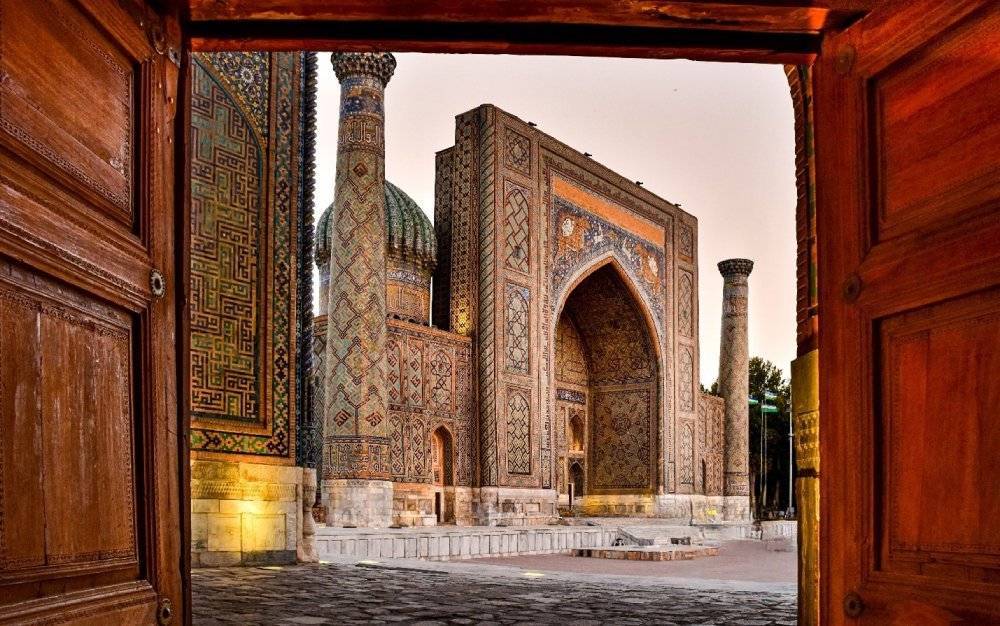Whether it’s Tiananmen Square in Beijing, the Eiffel Tower in Paris, or the Statue of Liberty in New York City, every city in the world has a place that can be used as a city symbol. As in the cities mentioned above, Samarkand city also has its symbol - Registan Square. Even though the square was built in the medieval ages, the origin of the area dates back to VIII-XIX centuries. It has always been the cultural and social centre of Samarkand city. Furthermore, it was the centre of learning in Mawarannahr (Transoxiana) and Khorasan. It is also important to mention that Samarkand is located on the Silk Road route and the square was the main place where foreign and local merchants met and traded at that time. Even today, it is very lively filled with local and international people. It is considered quite safe, as there are tourist and local police offices located nearby.
One can enjoy admiring architecture of different periods, and at night-time, visitors can see light shows with traditional Uzbek music. The area is so diverse, with Timurid and Shaybanid constructions and Persian influence on the decorations. In front of the square, there is a residential building constructed during the Soviet era and next to the square, there is a green park built after the independence of the country. An interesting thing about the area is that all buildings of the urban area were erected respectfully, so they do not affect each other.
Tourists visiting ancient Samarkand are amazed by the beauty of the three madrasas built in Registan Square. Since the time of Mirzo Ulugbek, this square has been the main square for the people of Samarkand. The edicts of the rulers of Samarkand were read to the people from there. The brave soldiers who went to the battle of freedom against evil gathered in this square and received Dua (a prayer of invocation, supplication or request, even asking for help or assistance from God in Islam) from the elders. According to the archaeological excavations conducted in Registan Square, many buildings began to appear in the square in the 8th-10th centuries. This is because the Arabs, who conquered Samarkand forcibly, relocated several thousand local residents from Afrasiab to the area around Registan. After the relocation, craftsmen's workshops and stalls were built there.
In the 11th and 12th centuries, the area of the current Registan Square and the surrounding neighbourhoods were surrounded by an outer defensive wall and were called the "outer city". After Afrasiab was destroyed by Genghis Khan in 1220, it was no longer possible to live there. So, the surviving people moved to the current old city around Registan Square. The channel flowing from there widens and becomes shallower. After that, a new bed for the channel was dug and curbed. Due to the large amount of sand accumulated in the old channel bed, this place was called Registan, which means, "sandy place". During the reign of Amir Temur (1336-1405), the central bazaar was built on Registan Square, and a covered shopping mall was built on the square, built by Tuman Aga, the wife of Jahongir (1356-1376).
The architectural formation of Registan Square began during the reign of Mirzo Ulugbek (1394-1449). The great astrologer and scientist Mirzo Ulugbek, who ruled in Samarkand for 40 years (1409-1449), spared nothing in the improvement of this city. According to the decree of Mirzo Ulugbek, the construction of a luxurious madrasa began on the west side of Tuman Agha Timi. This madrasa, completed in 1420, was admired by its contemporaries for its strength and beauty. Four tall minarets were built at the four corners of the madrasa. In the inner courtyard of the madrasa, several comfortable and cosy rooms and classrooms were built by highly skilled architects. Also, the inner and outer walls of the madrasa were decorated with colourful tiles. In the pond in the courtyard of the madrasah, water shimmered, and when the sunlight hit it, the patterns on the walls were reflected to a dazzling extent.
In addition to building a luxurious madrasa, Mirzo Ulugbek also built a huge palace and a magnificent caravanserai in Registan. For this, old buildings were levelled. Apart from these, Mirzo Ulugbek also built a new hammam (a place of public bathing) near the caravanserai. This structure, known as Mirza Hammami, had a special place in the architecture of the Timurid period with its architectural solutions. According to Mirza Babur, this kind of wonderful hammam was the only one in Movarounnahr and Khorasan. A luxurious mosque built by Alika Kokaltash, Mirzo Shahrukh's tutor, also stood on the current Registan Square. While writing about Samarkand, Mirza Babur also mentions the Muqatta Mosque built by Ulugbek on Registan Square. This mosque stood on the southern side of Ulugbek madrasa.
After the Timurids, the Shaibanis, who sat on the throne of Samarkand, also did great things in the improvement of this city. According to the historian Hafiz Tanish Bukhari, Abdulla Khan ordered the repair of architectural monuments in Samarkand twice in 1581 and 1587, and a lot of money was spent for this purpose.
At the beginning of the 17th century, Registan Square became a huge construction site. On the square, the governor of Samarkand, Yalangtosh Bahadir, (emir of Samarkand between 1626-1656) built two madrasas. The construction of the Sherdor Madrasa, which stood on the opposite side of the Ulugbek Madrasa, began in 1619. The architects who created the project of this madrasa tried to make it similar to the Ulugbek Madrasa. Because of this, the height of the pediment, blue domes, and salubrious minarets of the Sherdor Madrasa all resemble the Ulugbek Madrasa. However, the tiles and decorations of the Sherdor Madrasa are unique.
The images of the tiger, carrying the human-faced sun on its back, and the hiccups and snarling deer on the facade of the Sherdor Madrasa add beauty to this madrasa. The names of master architect Abdul Jabbar, who built it, and master craftsman Muhammad Abbas, who created architectural decorations, are forever imprinted on the walls of the Sherdor Madrasa. On the walls of the madrasa, the name of the governor of Samarkand, Yalangtoshbiy Bahadir, who built it, and the hymn written in his name are preserved. At the time of its construction, this madrasa was called “Big Madrasa of Yalangtoshbi”. However, the name didn’t find its usage among people and documents. In later times it was called Sherdor.
The third madrasa built in Registan Square is the Tillakori Madrasa. This madrasa was also built by Yalangtosh Bahodur, and according to historical sources, it took 17 years to complete. The pediment of the Tillakori Madrasa is as high and majestic as that of the Ulugbek and Sherdar madrasas. By the 17th century, the Amir Timur Jami' Mosque had become a ruin, and the Alika Kokaldosh Mosque in Registan was completely destroyed. Therefore, the people of Samarkand needed a new mosque. Yalantushbi Bahadur, who understood this well, decided to integrate a luxurious mosque in the newly built madrasa. The architects understood the ruler's intention well and transferred it to the project. The courtyard of the madrasa was also built to make it convenient for those who come to pray there. A lot of gold was used to decorate the mosque and madrasa, so its walls were shining. For this reason, during the construction period, this madrasa was called "Little Madrasah of Yalangtushbi" and later on it was called "Tilakori".
Tiles and mosaic panels on the walls of Tillakori mosque-madrasa are unique. In these three magnificent madrasahs standing on the Registan Square, hundreds of students were educated in science for several centuries. They were taught by some great scholars of their time. Today, Registan has become the main square where important cultural events are held in the life of Uzbekistan. In 2001, these three madrasas were included in the UNESCO World Heritage List.















